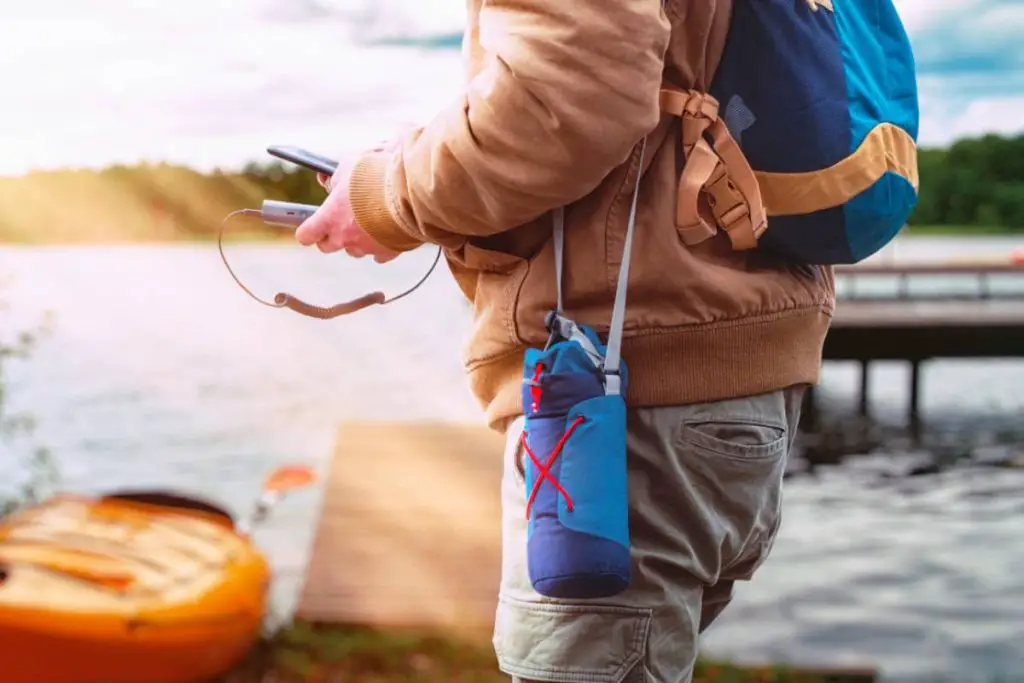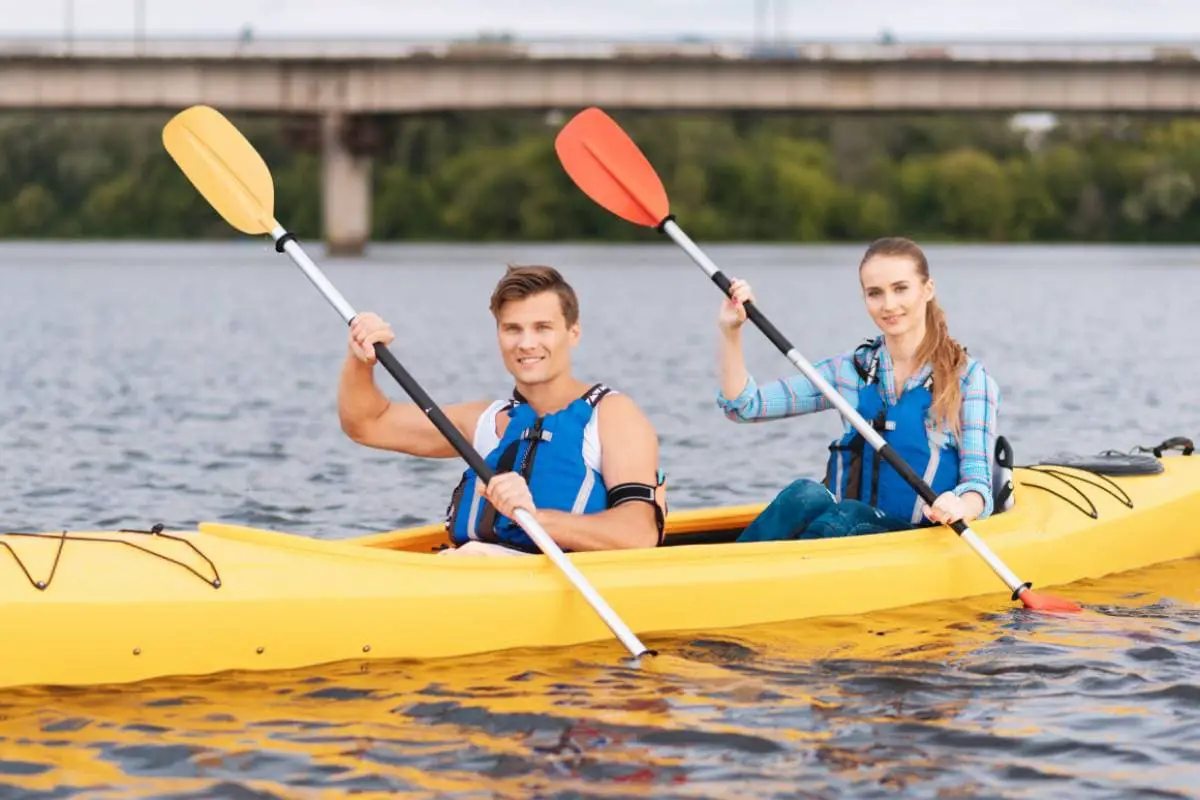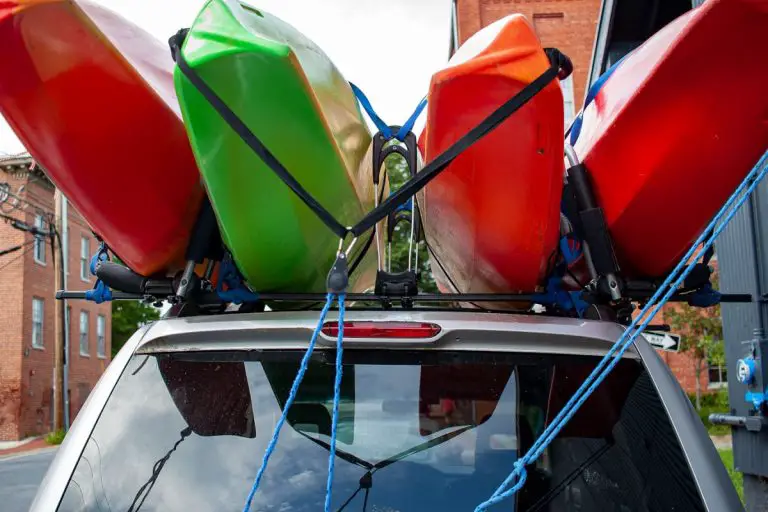How To Stay Dry in a Kayak (10 Easy Ways)
Getting a bit wet while kayaking is inevitable, but getting very wet can be uncomfortable, especially in cold weather. Whether you’re opting for a sit-on-top or sit-in kayak, it’s possible to stay relatively dry or at least minimize how much water gets on you while kayaking.
You can stay dry in a kayak by fitting your sit-inside kayak with a spray skirt or spray deck or by wearing a drysuit or a kayaking wetsuit in a sit-on-top kayak. You can also use a shallow paddle with drip rings and use a kayak bilge pump to minimize water puddles.
In this article, you will understand the different ways water gets into a kayak, and get an in-depth explanation of how to stay dry in a kayak. In addition, I will list the best kayaks for staying dry, and how to stay safe on your kayaking adventure.

How Water Gets Into A Kayak
Water can get into your kayak in different ways, and many of them are unavoidable in a kayaking experience.
- A wave could gently hit your kayak when you’re in the water. Even a small wave could mean water getting into the kayak.
- Getting in and out of your kayak at the shore can get water on your ankles and feet. This might transfer a small amount of water into the bottom of your kayak.
- While you’re paddling your kayak at a high angle and high speed, water runs down the shaft of the paddle when you raise it. That water pools into your kayak so slowly that you might not even notice until there’s a lot of it in there. The water-pooling problem may get even worse if you’re paddling without proper technique.
- Most kayaks also have low freeboards, meaning that the distance from the waterline to the sides of the kayak isn’t very far. In this case, it’s pretty easy for water to spray into it or to seep in through screws and rivet holes.
- If your kayak capsizes, you’re very likely to get more soaked than just wet. Capsizing will get water into every part of your kayak except parts covered with proper waterproof material.
If more water than usual is getting into your kayak, though, you should immediately carry out a routine check for a hole or crack in every possible place. If you find one, plug it as soon as you can, and reassess the situation.
If the seepage is still bad, paddle to the shore immediately to get it checked out. It’s easy to deal with some kayaks capsizing, but it can be more difficult for others, especially the sit-in type, so you shouldn’t take the chance.
How To Stay Dry in a Kayak
Staying dry in a kayak might take some precision, but with some care, you may be able to minimize the amount of water that gets into the kayak.
Fit Your Sit-Inside Kayak With a Spray-Skirt or Spray Deck
Though it has its other downsides, a sit-inside kayak is a better bet for staying dry because most of your body stays covered in it, unlike the sit-on-top type.
Fitting a spray skirt around your sit-in kayak helps keep water out efficiently. A spray skirt or spray deck is a flexible and waterproof neoprene or nylon cover with a hole—usually in the cockpit space—for your waist to fit in.
The openings in a properly-used spray skirt are usually made watertight through elastic fabric and drawstring. The spray skirt leaves your upper torso free to paddle while shielding the rest of your body from the spraying water, and it also keeps water out of the cockpit of the kayak.
You should be careful to choose the best spray skirt for your kayak type because the wrong type could cause water to pool around your waist instead of keeping the water out entirely. Getting the spray skirt on can also be difficult for some people, especially women, so you may want to figure out your spray skirt before it’s time to go kayaking!

Wear a Drysuit or a Kayaking Wetsuit
If you’re opting for a sit-on-top kayak, or you’d like to stay dry and warm in your sit-in one, a drysuit is an excellent choice. It’s a loose-fitting, completely watertight protective garment that allows you to wear insulating clothing underneath it. The loose nature of drysuits also helps them trap warm air between your body and the inner parts of the suit, so you stay warm and dry.
For example, the Kokatat Men’s Hydrus Supernova Semi-Dry Paddling Suit from Amazon.com will help keep you both warm and dry when out paddling.
It is important to keep the water away from you if its temperature drops below 60°F. Water conducts heat away from the body very fast, so if you find yourself in very cold water, hypothermia can set in quickly. A drysuit can help prevent that and keep you warm when kayaking in cold weather conditions.
Wetsuits are similar to drysuits, but they are form-fitting, meaning that you cannot wear insulating cloth layers under them. However, they allow for quicker movement. They are less breathable than drysuits but built for insulation, so they are more efficient in keeping you warm.
As an example, take a look at the Dark Lightning Full Body Wetsuit at Amazon.com. It will do a good job of keeping you warm, but not dry. Wetsuits only work when they are wet by trapping a thin layer of water between the suit and the skin. The body warms this layer of water to keep you warm.
Drysuits can work in a lot more environments than wetsuits, especially because you can change the undergarments throughout the year for warmer or cooler conditions, but they are more expensive and require more care.
Wear Layered, Warm Clothing, Especially if It’s Raining
Waders, rain-resistant coats, gloves, and light, insulating clothing can be kayaking lifesavers. They help make sure that you stay snug and dry and also ensure that any water can roll right off without soaking through your clothes.
Besides water, you need to keep your body insulated from the wind and rain to avoid hypothermia, and that’s where your clothes come in. Whatever clothes you plan to wear under your waterproof covers have to be light enough to allow airflow and prevent overheating, and in multiple layers to keep a nice insulating layer of air around your body.

Wear Waterproof Trousers
Even when you take all due precautions, many factors can make it inevitable for water to seep into your kayak and pool at the bottom. To prepare for this and keep yourself dry if it happens, you should wear waterproof trousers.
Jeans and anything made of cotton are a no-no for kayaking, but clothes from synthetic materials like polyester or fleece will do a much better job.
Take a Kayak Bilge Pump With You
It may not be a big deal when a little bit of water pools in a part of your kayak, but if it gets too much, it can cause a problem. A kayak bilge pump (Amazon) helps you pump out the water that has seeped into your kayak and accumulated there.
This will help to remove water that may run down the paddle shaft or excess water that could get in after your kayak capsizes.
Choose a Kayak With a High Seat
Water will nearly always pool at the bottom of sit-on-top kayaks, and having that water in the bottom can be annoying. Some sit-on-top kayaks have high seats, sometimes up to 6 inches above the boat floor, and seats like these help to keep you dry.
Others may have inflatable seats that go some inches above the water that pools and sloshes around at the bottom of the kayak.
The downside to these high seats is that they reduce the kayak’s stability to a considerable degree, so you should be careful about the height of the seat you opt for. It may be a good idea to get some practice with your kayak seat to be sure it’s reasonably stable before you launch.
Take a Dry Bag or Dry Box Along
Whether it’s your change of clothes, your phone, an emergency kit, or any belongings you want to keep safe and dry on your kayaking adventure, a dry bag or dry box is your go-to tool. It’s not advisable to take your phone along while kayaking, but a change of clothes is very important in case your outfit gets wet.
The relatively inexpensive Earth Pak -Waterproof Dry Bag (Amazon) could really save the day if you take on more water than you were expecting on your next kayaking adventure.

Use a Shallow Paddle With Drip Rings and Paddle Correctly
The type of paddle you use can determine a lot about how much water will get into your kayak, especially if it’s a sit-on-top kayak. The top performance paddles usually have grooves that ensure the highest thrust out of every paddle.
However, these also tend to scoop up water with every paddle and get your kayak wet faster. If you’re more particular about not getting wet than high performance, you should use a flat, shallow paddle that’ll scoop up less water.
To minimize water running down your paddle shaft and pooling inside the kayak, keep the paddle as horizontal as you can when using it. You could also use a drip ring on your paddle.
A drip ring is a rubber ring that can fit around your paddle to stave off the water running down your paddle shaft before it reaches your body. Some newer paddle designs already have drip rings, but you can get one for your paddle if a drip ring doesn’t already come with it.
There are lots of online resources on building a drip ring yourself if you’d like to try that too! Check out the video below to make DIY drip rings for cheap.
For your drip ring to work effectively, make sure you place it above the waterline. Remember that it’s there to stop running water from running down your shaft, so if you dip it into the water with the lower part of your paddle, it will scoop up water with the paddle shaft instead of stopping it.
Coat Your Kayak With Wax and Use a Scupper Plug
If you own a composite kayak, use a polyurethane brush to apply a coat of kayak wax on it from time to time, depending on how often you use it. The wax coat protects your kayak from the sun’s harmful rays. It also makes it more durable and resistant to scratches and dents that could cause water to leak into it.
Sit-on-top kayaks also have scupper holes built into their sides. These allow the water that gets in to leak out, but most of these kayaks are so low that water ends up coming in through the scupper holes, especially while you’re trying to enter the kayak. Installing a scupper plug into your scupper holes can help a lot with keeping water out of your kayak.
You have to be careful and use your discretion to determine where to use scupper plugs, though, because the scupper plugs are essential self-bailing safety tools that help keep your kayak from capsizing.
Self-draining scupper plugs that keep water out and provide drainage inside your kayak could also be great tools, but they are relatively new products, so you should check them out very carefully before making a purchase.

Don’t Go Kayaking in Extreme Conditions
If the weather conditions seem extreme, it’s nearly always a good idea to err on the side of caution and postpone your kayaking adventure. Kayaking in light rain might be fine if you have the proper gear and you are fully prepared.
However, in heavy rain, your kayak will fill up with water very quickly, make kayaking extra difficult, and put you at risk of capsizing. The water levels may also reach a higher level than usual, making paddling difficult.
Additionally, kayaking in windy conditions might pose a few problems. If it’s windy enough, it could push your kayak too much to one side, making you much more likely to get wet or even capsize.
How To Stay Dry in a Kayak – Conclusion
Know you know how to stay dry in a kayak! Keeping all of this in mind can be hard work, but with practice, you’ll get better at staying dry while kayaking.
When you’re out on the water, remember that staying safe is more important than staying dry, so be careful and follow all safety precautions.
Your choice of kayak shouldn’t revolve only around how dry it’ll keep you. Consider how much kayaking experience you’ve had, what kind of water you’re planning to paddle into, and the stability of your boat.
You’re all set to go kayaking while staying dry!







